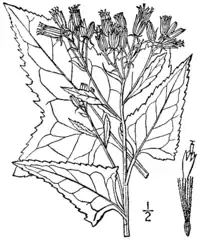Hasteola suaveolens
Hasteola suaveolens, known by the common names false Indian plantain and sweet scented Indian plantain, is a perennial forb native to the northeastern and north-central United States. It is found from Massachusetts south to Virginia and North Carolina, and west as far as Minnesota and Minnesota and Missouri.[2][3]
| Hasteola suaveolens | |
|---|---|
 | |
| Scientific classification | |
| Kingdom: | Plantae |
| Clade: | Tracheophytes |
| Clade: | Angiosperms |
| Clade: | Eudicots |
| Clade: | Asterids |
| Order: | Asterales |
| Family: | Asteraceae |
| Genus: | Hasteola |
| Species: | H. suaveolens |
| Binomial name | |
| Hasteola suaveolens | |
| Synonyms[1] | |
Description

Hasteola suaveolens is a perennial herb sometimes as much as 240 cm (8 feet) tall, hairless throughout, unbranched below the inflorescence. The spearhead shaped (hastate) leaves are 10 to 25 cm (4 to 10 in) long and 5 to 15 cm (2 to 6 in) wide with serrated (toothed) edges. The plant flowers in late summer or early fall. The inflorescence is one or several roughly flat topped clusters of several to many flower heads consisting entirely of 18–55 white or very pale yellow disc florets, but no ray florets. The fruit is a cypsela with a pappus of white bristles.[4][5][6]
Distribution and habitat
Hasteola suaveolens has a native range that includes twenty-two states east and two states west of the Mississippi River,[7] in eastern and central USA. It is listed as an endangered species in the states of Connecticut, Maryland, Minnesota and New York, it is listed as threatened in Iowa and Tennessee, and it is listed as historical in Rhode Island, meaning that it is presumed extirpated.[2] Hasteola suaveolens is now less common or absent in the northern part of its range.[5] There may be only one population left of this species in all of New England.[6] In Virginia, it grows in habitats such as floodplain forests and riverbanks, along the Potomac, Shenandoah, and New rivers.[8] The presence of this species is dependent on appropriate habitat, and it may be eliminated from an area by development, changes in land use, or competition with invasive species. In Minnesota the native habitat is wet meadows along stream banks and the edges of marshes but due to the loss of much these habitats it may be restricted to wet ditches.[9]
References
- "Hasteola suaveolens". The Global Compositae Checklist (GCC) – via The Plant List. Note that this website has been superseded by World Flora Online
- USDA, NRCS (n.d.). "Hasteola suaveolens". The PLANTS Database (plants.usda.gov). Greensboro, North Carolina: National Plant Data Team. Retrieved February 12, 2014.
- "Senecio suaveolens". County-level distribution map from the North American Plant Atlas (NAPA). Biota of North America Program (BONAP). 2014.
- Britton, Nathaniel Lord & Brown, Addison (1913). An Illustrated Flora of the Northern United States, Canada and the British Possessions: From Newfoundland to the Parallel of the Southern Boundary of Virginia, and from the Atlantic Ocean Westward to the 102d Meridian, Volume 3., p. 538. Charles Scribner's Sons, New York.
- Anderson, Loran C. (2006). "Hasteola suaveolens". In Flora of North America Editorial Committee (ed.). Flora of North America North of Mexico (FNA). Vol. 20. New York and Oxford: Oxford University Press. Retrieved February 12, 2014 – via eFloras.org, Missouri Botanical Garden, St. Louis, MO & Harvard University Herbaria, Cambridge, MA.
- "Senecio suaveolens (false Indian-plantain)". Go Botany. New England Wildflower Society. Retrieved February 12, 2014.
- "New England Plant Conservation Program Conservation and Research Plan Hasteola suaveolens (L.) Pojark. Sweet Indian Plantain" (PDF). nativeplanttrust.org. Retrieved December 7, 2020.
- "Digital Atlas of the Virginia Flora | Senecio suaveolens (L.) Ell". Retrieved February 12, 2014. Virginia Botanical Associates. (2014). Digital Atlas of the Virginia Flora (http://www.vaplantatlas.org). c/o Virginia Botanical Associates, Blacksburg.
- Barbara Coffin; Lee Pfannmuller (1988). Minnesota's Endangered Flora and Fauna. U of Minnesota Press. p. 61. ISBN 978-0-8166-1689-3.